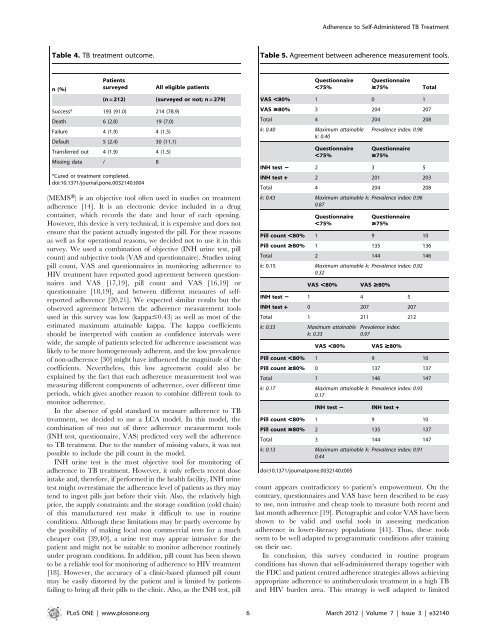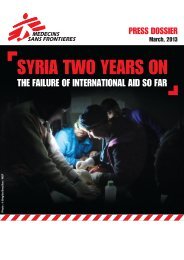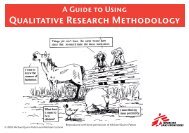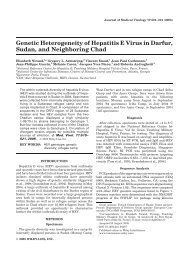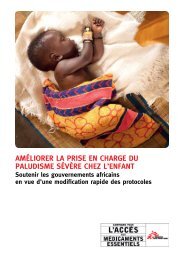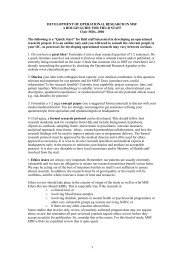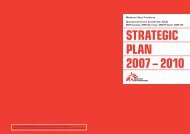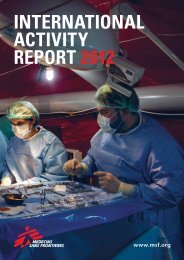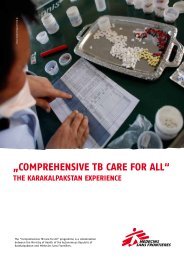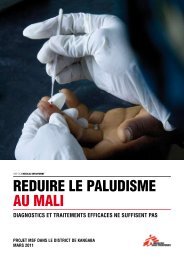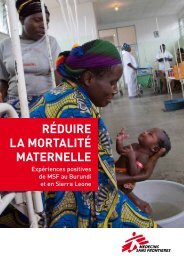<strong>Adherence</strong> <strong>to</strong> <strong>Self</strong>-<strong>Administered</strong> TB <strong>Treatment</strong>Table 4. TB treatment outcome.Table 5. Agreement between adherence measurement <strong>to</strong>ols.n(%)PatientssurveyedAll eligible patients(n = 212) (surveyed or not; n = 279)Success* 193 (91.0) 214 (78.9)Death 6 (2.8) 19 (7.0)Failure 4 (1.9) 4 (1.5)Default 5 (2.4) 30 (11.1)Transferred out 4 (1.9) 4 (1.5)Missing data / 8*Cured or treatment completed.doi:10.1371/journal.pone.0032140.t004(MEMSH) is an objective <strong>to</strong>ol often used in studies on treatmentadherence [14]. It is an electronic device included in a drugcontainer, which records the date and hour of each opening.However, this device is very technical, it is expensive and does notensure that the patient actually ingested the pill. For these reasonsas well as for operational reasons, we decided not <strong>to</strong> use it in thissurvey. We used a combination of objective (INH urine test, pillcount) and subjective <strong>to</strong>ols (VAS and questionnaire). Studies usingpill count, VAS and questionnaires in moni<strong>to</strong>ring adherence <strong>to</strong>HIV treatment have reported good agreement between questionnairesand VAS [17,19], pill count and VAS [16,19] orquestionnaire [18,19], and between different measures of selfreportedadherence [20,21]. We expected similar results but theobserved agreement between the adherence measurement <strong>to</strong>olsused in this survey was low (kappa#0.43) as well as most of theestimated maximum attainable kappa. The kappa coefficientsshould be interpreted with caution as confidence intervals werewide, the sample of patients selected for adherence assessment waslikely <strong>to</strong> be more homogeneously adherent, and the low prevalenceof non-adherence [30] might have influenced the magnitude of thecoefficients. Nevertheless, this low agreement could also beexplained by the fact that each adherence measurement <strong>to</strong>ol wasmeasuring different components of adherence, over different timeperiods, which gives another reason <strong>to</strong> combine different <strong>to</strong>ols <strong>to</strong>moni<strong>to</strong>r adherence.In the absence of gold standard <strong>to</strong> measure adherence <strong>to</strong> TBtreatment, we decided <strong>to</strong> use a LCA model. In this model, thecombination of two out of three adherence measurement <strong>to</strong>ols(INH test, questionnaire, VAS) predicted very well the adherence<strong>to</strong> TB treatment. Due <strong>to</strong> the number of missing values, it was notpossible <strong>to</strong> include the pill count in the model.INH urine test is the most objective <strong>to</strong>ol for moni<strong>to</strong>ring ofadherence <strong>to</strong> TB treatment. However, it only reflects recent doseintake and, therefore, if performed in the health facility, INH urinetest might overestimate the adherence level of patients as they maytend <strong>to</strong> ingest pills just before their visit. Also, the relatively highprice, the supply constraints and the s<strong>to</strong>rage condition (cold chain)of this manufactured test make it difficult <strong>to</strong> use in routineconditions. Although these limitations may be partly overcome bythe possibility of making local non commercial tests for a muchcheaper cost [39,40], a urine test may appear intrusive for thepatient and might not be suitable <strong>to</strong> moni<strong>to</strong>r adherence routinelyunder program conditions. In addition, pill count has been shown<strong>to</strong> be a reliable <strong>to</strong>ol for moni<strong>to</strong>ring of adherence <strong>to</strong> HIV treatment[18]. However, the accuracy of a clinic-based planned pill countmay be easily dis<strong>to</strong>rted by the patient and is limited by patientsfailing <strong>to</strong> bring all their pills <strong>to</strong> the clinic. Also, as the INH test, pillQuestionnaire,75%Questionnaire$75% TotalVAS ,80% 1 0 1VAS $80% 3 204 207Total 4 204 208k: 0.40 Maximum attainablek: 0.40Prevalence index: 0.98Questionnaire,75%Questionnaire$75%INH test 2 2 3 5INH test + 2 201 203Total 4 204 208k: 0.43 Maximum attainable k: Prevalence index: 0.960.87Questionnaire,75%Questionnaire$75%Pill count ,80% 1 9 10Pill count $80% 1 135 136Total 2 144 146k: 0.15 Maximum attainable k: Prevalence index: 0.920.32VAS ,80% VAS $80%INH test 2 1 4 5INH test + 0 207 207Total 1 211 212k: 0.33 Maximum attainablek: 0.33Prevalence index:0.97VAS ,80% VAS $80%Pill count ,80% 1 9 10Pill count $80% 0 137 137Total 1 146 147k: 0.17 Maximum attainable k: Prevalence index: 0.930.17INH test 2 INH test +Pill count ,80% 1 9 10Pill count $80% 2 135 137Total 3 144 147k: 0.13 Maximum attainable k: Prevalence index: 0.910.44doi:10.1371/journal.pone.0032140.t005count appears contradic<strong>to</strong>ry <strong>to</strong> patient’s empowerment. On thecontrary, questionnaires and VAS have been described <strong>to</strong> be easy<strong>to</strong> use, non intrusive and cheap <strong>to</strong>ols <strong>to</strong> measure both recent andlast month adherence [19]. Pic<strong>to</strong>graphic and color VAS have beenshown <strong>to</strong> be valid and useful <strong>to</strong>ols in assessing medicationadherence in lower-literacy populations [41]. Thus, these <strong>to</strong>olsseem <strong>to</strong> be well adapted <strong>to</strong> programmatic conditions after trainingon their use.In conclusion, this survey conducted in routine programconditions has shown that self-administered therapy <strong>to</strong>gether withthe FDC and patient centred adherence strategies allows achievingappropriate adherence <strong>to</strong> antituberculosis treatment in a high TBand HIV burden area. This strategy is well adapted <strong>to</strong> limitedPLoS ONE | www.plosone.org 6 March 2012 | Volume 7 | Issue 3 | e32140
<strong>Adherence</strong> <strong>to</strong> <strong>Self</strong>-<strong>Administered</strong> TB <strong>Treatment</strong>Table 6. Posterior probability of adherence (latent classanalysis).VAS Questionnaire INH test Probability of being adherent+ + + 1+ + 2 1+ 2 + 1+ 2 2 0.032 + + 12 + 2 0.012 2 + 0.512 2 2 0+: complete or satisfac<strong>to</strong>ry adherence.2: unsatisfac<strong>to</strong>ry adherence.doi:10.1371/journal.pone.0032140.t006resources settings. However, these results can not be directlyextrapolated in settings where single antituberculosis drugs areadministered separately. Although the use of a combination of twoReferences1. Word Health Organisation (2006) The S<strong>to</strong>p TB Strategy. Building on andenhancing DOTS <strong>to</strong> meet the TB-related Millennium Development Goals.Geneva: WHO press.2. Atun RA, Samyshkin YA, Drobniewski F, Skura<strong>to</strong>va NM, Gusarova G, et al.(2005) Barriers <strong>to</strong> sustainable tuberculosis control in the Russian Federationhealth system. Bull World Health Organ 83: 217–223.3. Fochsen G, Deshpande K, Ringsberg KC, Thorson A (2009) Conflictingaccountabilities: Doc<strong>to</strong>r’s dilemma in TB control in rural India. Health Policy89: 160–167.4. Steffen R, Menzies D, Oxlade O, Pin<strong>to</strong> M, de Castro AZ, et al. (2010) Patients’costs and cost-effectiveness of tuberculosis treatment in DOTS and non-DOTSfacilities in Rio de Janeiro, Brazil. PLoS One 5: e14014.5. Volmink J, Garner P (2007) Directly observed therapy for treating tuberculosis.Cochrane Database Syst Rev. CD003343.6. Verma G, Upshur RE, Rea E, Benatar SR (2004) Critical reflections onevidence, ethics and effectiveness in the management of tuberculosis: publichealth and global perspectives. BMC Med Ethics 5: E2.7. Selgelid MJ, Reichman LB (2011) Ethical issues in tuberculosis diagnosis andtreatment. Int J Tuberc Lung Dis 15 Suppl 2: S9–13.8. Mafigiri DK, McGrath JW, Whalen CC (2011) Task shifting for tuberculosiscontrol: A qualitative study of community-based directly observed therapy inurban Uganda. Glob Public Health. pp 1–15.9. Bangalore S, Kamalakkannan G, Parkar S, Messerli FH (2007) Fixed-dosecombinations improve medication compliance: a meta-analysis. Am J Med 120:713–719.10. Blomberg B, Spinaci S, Fourie B, Laing R (2001) The rationale forrecommending fixed-dose combination tablets for treatment of tuberculosis.Bull World Health Organ 79: 61–68.11. Connor J, Rafter N, Rodgers A (2004) Do fixed-dose combination pills or uni<strong>to</strong>f-usepackaging improve adherence? A systematic review. Bull World HealthOrgan 82: 935–939.12. Lienhardt C, Cook SV, Burgos M, Yorke-Edwards V, Rigouts L, et al. (2011)Efficacy and safety of a 4-drug fixed-dose combination regimen compared withseparate drugs for treatment of pulmonary tuberculosis: the Study C randomizedcontrolled trial. JAMA 305: 1415–1423.13. Raguenaud ME, Zachariah R, Massaquoi M, Ombeka V, Ritter H, et al. (2008)High adherence <strong>to</strong> anti-tuberculosis treatment among patients attending ahospital and slum health centre in Nairobi, Kenya. Global Public Health 3:433–439.14. Osterberg L, Blaschke T (2005) <strong>Adherence</strong> <strong>to</strong> medication. N Engl J Med 353:487–497.15. Word Health Organisation (2003) <strong>Adherence</strong> <strong>to</strong> long-term therapies: evidencefor action. Geneva: WHO press.16. Giordano TP, Guzman D, Clark R, Charlebois ED, Bangsberg DR (2004)Measuring adherence <strong>to</strong> antiretroviral therapy in a diverse population using avisual analogue scale. HIV Clin Trials 5: 74–79.17. Amico KR, Fisher WA, Cornman DH, Shuper PA, Redding CG, et al. (2006)Visual analog scale of ART adherence: association with 3-day self-report andadherence barriers. J Acquir Immune Defic Syndr 42: 455–459.simple <strong>to</strong>ols, such as the VAS and a questionnaire, might be anadequate approach <strong>to</strong> moni<strong>to</strong>r adherence <strong>to</strong> TB treatment inroutine program conditions, further validation is required. Also, inthe future, other <strong>to</strong>ols might play a role in the support andmoni<strong>to</strong>ring of adherence <strong>to</strong> TB treatment, in particular communicationdevices such as mobile phones, which are more and moreavailable in high burden and limited resource countries [42,43].AcknowledgmentsThis study was sponsored by Médecins Sans Frontières, France. TheDirec<strong>to</strong>r, KEMRI, Kenya, is acknowledged for authorising this study andpermitting the publication of this manuscript. Cathy Hewison, PhilippeBlasco, Emmanuelle Chazal and Bruno Spire are acknowledged for theirrelevant advice. We would also like <strong>to</strong> thank the survey teams, MSF fieldteam and the patients who <strong>to</strong>ok part in this study.Author ContributionsConceived and designed the experiments: FN M. Bonnet HH EE FV JC JSAOA. Performed the experiments: EE HH. Analyzed the data: FN M.Bonnet M. Bastard JFE. Wrote the paper: FN HH EE AOA M. BastardJFE JS FV JC M. Bonnet.18. Bangsberg DR, Hecht FM, Charlebois ED, Zolopa AR, Holodniy M, et al.(2000) <strong>Adherence</strong> <strong>to</strong> protease inhibi<strong>to</strong>rs, HIV-1 viral load, and development ofdrug resistance in an indigent population. AIDS 14: 357–366.19. Oyugi JH, Byakika-Tusiime J, Charlebois ED, Kityo C, Mugerwa R, et al.(2004) Multiple validated measures of adherence indicate high levels ofadherence <strong>to</strong> generic HIV antiretroviral therapy in a resource-limited setting.J Acquir Immune Defic Syndr 36: 1100–1102.20. Mannheimer S, Thackeray L, Huppler HK, Chesney M, Gardner EM, et al.(2008) A randomized comparison of two instruments for measuring self-reportedantiretroviral adherence. AIDS Care 20: 161–169.21. Mannheimer SB, Mukherjee R, Hirschhorn LR, Dougherty J, Celano SA, et al.(2006) The CASE adherence index: A novel method for measuring adherence <strong>to</strong>antiretroviral therapy. AIDS Care 18: 853–861.22. Bangsberg DR (2006) Moni<strong>to</strong>ring adherence <strong>to</strong> HIV antiretroviral therapy inroutine clinical practice: The past, the present, and the future. AIDS Behav 10:249–251.23. World Health Organization (2010) Kenya. <strong>Tuberculosis</strong> profile 2009. www whoint/tb/data Accessed 2011 Apr. 12.24. National AIDS and STI Control Programme K (2008) Kenya AIDS Indica<strong>to</strong>rSurvey 2007: Preliminary Report.25. NACC: National AIDS and STI Control Council (2005) Kenya HIV/AIDSData Booklet.26. Huerga H, Spillane H, Guerrero W, Odongo A, Varaine F (2010) Impact ofintroducing human immunodeficiency virus testing, treatment and care in atuberculosis clinic in rural Kenya. Int J Tuberc Lung Dis 14: 611–615.27. International Union Against <strong>Tuberculosis</strong> Committee on Prophylaxis (1982)Efficacy of various durations of isoniazid preventive therapy for tuberculosis: fiveyears of follow-up in the IUAT trial. Bull World Health Organ 60: 555–564.28. Elizaga J, Friedland JS (1997) Moni<strong>to</strong>ring compliance with antituberculoustreatment by detection of isoniazid in urine. Lancet 350: 1225–1226.29. Word Health Organisation (2010) <strong>Treatment</strong> of tuberculosis: guidelines – 4 thedition. Geneva: WHO press.30. Sim J, Wright CC (2005) The kappa statistic in reliability studies: use,interpretation, and sample size requirements. Phys Ther 85: 257–268.31. Pepe MS, Janes H (2007) Insights in<strong>to</strong> latent class analysis of diagnostic testperformance. Biostatistics 8: 474–484.32. Tuyisenge L, Ndimubanzi CP, Ndayisaba G, Muganga N, Menten J, et al.(2010) Evaluation of latent class analysis and decision thresholds <strong>to</strong> guide thediagnosis of pediatric tuberculosis in a Rwandan reference hospital. PediatrInfect Dis J 29: e11–e18.33. Macq J, Torfoss T, Getahun H (2007) Patient empowerment in tuberculosiscontrol: reflecting on past documented experiences. Trop Med Int Health 12:873–885.34. Munro SA, Lewin SA, Smith HJ, Engel ME, Fretheim A, et al. (2007) Patientadherence <strong>to</strong> tuberculosis treatment: a systematic review of qualitative research.PLoS Med 4: e238.35. Kaona FA, Tuba M, Siziya S, Sikaona L (2004) An assessment of fac<strong>to</strong>rscontributing <strong>to</strong> treatment adherence and knowledge of TB transmission amongpatients on TB treatment. BMC Public Health 4: 68.PLoS ONE | www.plosone.org 7 March 2012 | Volume 7 | Issue 3 | e32140


